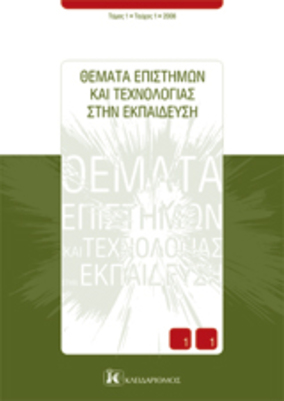Οι επιστήμονες, τα τηλεσκόπια και το φεγγάρι : ψηφιακές φωτο-ιστορίες για μαθητές Δημοτικού
Part of : Θέματα επιστημών και τεχνολογίας στην εκπαίδευση ; Vol.5, No.1-2, 2012, pages 85-98
Issue:
Pages:
85-98
Abstract:
Στην εργασία αυτή επίκεντρο είναι η ανάπτυξη διδακτικών υλικών αφηγηματικής μορφής σε συνδυασμό με την αξιοποίηση της φύσης και της ιστορίας των Φυσικών Επιστημών στη διδασκαλία της Α/θμιας εκπαίδευσης. Πιο συγκεκριμένα περιγράφεται η διαδικασία δημιουργίας δυο ψηφιακών φωτο-ιστοριών για τους επιστήμονες, τα τηλεσκόπια και το φεγγάρι. Η αναζήτηση ιστορικού υλικού, η σύνθεση σεναρίων, η αξιοποίηση των ΤΠΕ με επιλογή δωρεάν διαθέσιμου λογισμικού οδήγησαν στην παραγωγή δυο διδακτικών ψηφιακών αφηγήσεων, οι οποίες παρουσιάζονται. Τα βίντεο με τις φωτο-ιστορίες χρησιμοποιήθηκαν σε σχολικές τάξεις και φύλλα εργασίας με ανοικτά ερωτήματα δόθηκαν στους μαθητές πριν και μετά από τις διδακτικές παρεμβάσεις. Στην εργασία, επίσης, παρουσιάζονται ενδεικτικά κάποια στοιχεία για τις εμπειρίες των μαθητών με τις ψηφιακές αφηγήσεις και επισημαίνονται θετικές και αρνητικές πλευρές που διαπιστώθηκαν σε εννοιολογικό και τεχνικό επίπεδο.
Subject (LC):
Keywords:
αφηγηματικές μορφές μάθησης, ψηφιακό διδακτικό υλικό, ιστορία των ΦΕ στη διδακτική πράξη, φωτο-ιστορίες, διδακτικά σενάρια
Notes:
Περιέχει σχήματα και βιβλιογραφία, Το άρθρο περιέχεται στο ειδικό αφιέρωμα: "Αλληλεπιδράσεις εκπαιδευτικής έρευνας και πράξης στις Φυσικές Επιστήμες"
References (1):
- Adobe Systems Incorporated (2008). Digital photography and video guide - Digital Storytelling. Retrieved 12 May2009 from http://www.adobe.com/education/instruction/adsc/pdf/digital_storytelling.pdf.Bezemer, J. & Kress, G. (2008). Writing in Multimodal Texts: a Social Semiotic Account of Designs for Learning.Written Communication, 25(2), 166-195.Clark, R. (1985). Evidence for confounding in educational computing research. Journal of Educational ComputingResearch, 1(2), 137-48.Combs, A., & Beach, D. (1994). Stories and storytelling: Personalizing the social studies. The Reading Teacher, 47,464–471.Doyle, W. (2000). Authenticity. Paper presented at the annual meeting of the American Educational Research Association.Montreal, Quebec, Canada.Egan, K. (1989). Teaching as story telling: An alternative approach to teaching and curriculum in the elementary school.Chicago: University of Chicago Press.Fensham, P. (2001). Science as story: Science education by sStory. Asia-Pacific Forum on Science Learning andTeaching, 2(1). Retrieved 12 September 2012, from http://www.ied.edu.hk/apfslt.Griest, G. (1996). Computer education as an obstacle to integration and Internet working. Learning and Leadingwith Technology, 24(8), 59–63.Hermann, R., & Lewis, B. (2003). Moon misconceptions. The Science Teacher, 11, 51-55.Jonassen, D., Peck, K., & Wilson, B. (1999). Learning with technology: A constructivist perspective. Upper SaddleRiver, NJ: Prentice Hall.Jonassen, D. H. (2003). Designing research-based instruction for story problems. Educational Psychology Review,15(3), 267–296.Kafai, Y.B., & Gilliland-Swetland, A. J. (2001). The use of historical materials in elementary science classrooms.Science Education, 85(4), 349-367.Kozma, R. (1994). Will media influence learning: Reframing the debate. Educational Technology Research andDevelopment, 42(2), 7-19.Kozma, R. (2003). Material and social affordances of multiple representations for science understanding. Learningand Instruction, 13(2), 205-226.Koumi, J. (2006). Designing Video & Multimedia for Open and Flexible Learning. Oxon: Routledge.Lim, P., Nonis, D., & Hedberg, J. (2006). Gaming in a 3D multiuser virtual environment: Engaging students inscience lessons. British Journal of Educational Technology, 37(2), 211–231.Adobe Systems Incorporated (2008). Digital photography and video guide - Digital Storytelling. Retrieved 12 May2009 from http://www.adobe.com/education/instruction/adsc/pdf/digital_storytelling.pdf.Bezemer, J. & Kress, G. (2008). Writing in Multimodal Texts: a Social Semiotic Account of Designs for Learning.Written Communication, 25(2), 166-195.Clark, R. (1985). Evidence for confounding in educational computing research. Journal of Educational ComputingResearch, 1(2), 137-48.Combs, A., & Beach, D. (1994). Stories and storytelling: Personalizing the social studies. The Reading Teacher, 47,464–471.Doyle, W. (2000). Authenticity. Paper presented at the annual meeting of the American Educational Research Association.Montreal, Quebec, Canada.Egan, K. (1989). Teaching as story telling: An alternative approach to teaching and curriculum in the elementary school.Chicago: University of Chicago Press.Fensham, P. (2001). Science as story: Science education by sStory. Asia-Pacific Forum on Science Learning andTeaching, 2(1). Retrieved 12 September 2012, from http://www.ied.edu.hk/apfslt.Griest, G. (1996). Computer education as an obstacle to integration and Internet working. Learning and Leadingwith Technology, 24(8), 59–63.Hermann, R., & Lewis, B. (2003). Moon misconceptions. The Science Teacher, 11, 51-55.Jonassen, D., Peck, K., & Wilson, B. (1999). Learning with technology: A constructivist perspective. Upper SaddleRiver, NJ: Prentice Hall.Jonassen, D. H. (2003). Designing research-based instruction for story problems. Educational Psychology Review,15(3), 267–296.Kafai, Y.B., & Gilliland-Swetland, A. J. (2001). The use of historical materials in elementary science classrooms.Science Education, 85(4), 349-367.Kozma, R. (1994). Will media influence learning: Reframing the debate. Educational Technology Research andDevelopment, 42(2), 7-19.Kozma, R. (2003). Material and social affordances of multiple representations for science understanding. Learningand Instruction, 13(2), 205-226.Koumi, J. (2006). Designing Video & Multimedia for Open and Flexible Learning. Oxon: Routledge.Lim, P., Nonis, D., & Hedberg, J. (2006). Gaming in a 3D multiuser virtual environment: Engaging students inscience lessons. British Journal of Educational Technology, 37(2), 211–231.




